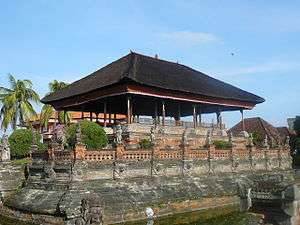Klungkung
Klungkung, also known as Semarapura, is a town in East Bali.
Understand

This is the administrative capital of the regency with the same name. The town is of great historical, cultural, and artistic significance.
Gelgel, just to the south of Klungkung, was the seat of the mighty Majapahit empire in the 15th and 16th century which moved to Klungkung itself in the 17th century. This was a golden age for art and culture in Bali, and Klungkung was the centre of it all.
More recently, Klungkung forever made its mark in modern Balinese history when in 1908, it was the last kingdom holding out against the Dutch invaders. Hopelessly outnumbered and outgunned, the King of Klungkung (the Dewa Agung or great god) led 200 members of his family and court in a puputan (ritual march to death), into the face of the Dutch guns. All of the group were either killed or committed ritual suicide.
- Tourism Information Office (at Taman Gili), ☎ +62 366 21448. M-F 8AM-2PM.
Get in
Few visitors stay in Klungkung but it is town that many pass through as it lies on the main route between between Ubud and points east to Padang Bai, Candidasa and beyond. The town is about 25 km south east from Ubud. Make a point of stopping here for a few hours and you will not be disappointed.
Get around
This is a small town and orientation is not difficult. The town is centred on a crossroads in the middle of which is the large Kanda Pat statue. If you are driving yourself, use this as your key landmark.
See
- Klungkung Palace (Kertha Gosa Pavilion), Semarapura. 17th century palace and court of justice.
- Gunarsa Museum of Classical & Modern Art (Museum Seni Lukis Klasik Bali), Takmung village (5 km west of the town centre on the main road to Gianyar). M-Sa 9AM-9PM. Owned by Nyoman Gunarsa, one of Bali's most famous modern artists, and exhibits his work. Also of great interest is a huge collection of traditional Balinese art and other objects. Really worth a visit and gets far less visitors than it deserves. Rp 25,000.
- Kamasan village (head south out of the town on Jalan Puputan towards Gelgel. Kamasan is signposted on the left). This ancient village is the centre of the classical wayang style of painting. Many studios to visit and a large amount of art to appreciate.
- Puputan Monument (at the crossroads in the town centre of Klungkung). This monument commemorates the 200 Balinese from the Klungkung royal family and court who died in the sacrificial puputan when fighting the Dutch in 1908. The large four sided statue in the centre of the same crossroads is the Kandi Pat Sare which symbolically guards the four cardinal points of the earth.
- Pura Masceti, Jl Prof Dr Ida Bagus Mantra, Pantai Masceti, Gianyar (from Klungkung head 7km south east to Kusamba where you turn west on the main bypass road which eventually leads back to Sanur. Pura Masceti is located beachside after about 15 km). This is the least well known and the least visited of Bali's nine directional temples. It serves as a guardian to the island from evil sea spirits. It is an elabaorately decorated temple and is often the start point for large purification ceremonies on the nearby beaches.
- River Unda (east of Klungkung). This is one of Bali's major rivers and you travel over it via a large bridge when leaving the town heading towards Padang Bai.
- Taman Gili (Kertha Gosa), Jalan Puputan, Klungkung. 7AM-6PM daily. The remains of the original palace of the Klungkung royal family. Especially notable is the painted ceiling of the Kerta Gosa pavilion as this is the only surviving example of classical wayang art in the whole of Bali. Much of the rest of the palace was destroyed when fighting the Dutch in the early 20th century but there are some other interesting remnants. The local government tourist office is also located here. Rp 6,000.
- Pura Goa Lawah (Bat Cave Temple), Pesinggahan. This is one of the 9 directional temples in Bali and important to all Balinese Hindus. This temple is built in front of a cave where thousands of bats sleep during the day. If you come shortly after sunset you will get to see the bats flying out of the temple in massive clouds. There is an entrance fee to be paid and you need to wear a sash and sarong (can be rented at the entrance)
Do
Try to take it all in. This is a town rich in history and culture. In the 17th century, the whole of Bali, Java, Lombok and Sumbawa was ruled by the royal court situated here.
Buy
Wayang art in the village of Kamasan.
Klungkung is the best place in Bali to buy traditional gongs.
Eat
Plenty of small local restaurants in the town centre and an excellent night market on Jalan Gunung Rinjani.
Drink
Sleep
Very few visitors stay the night in Klungkung choosing instead the nearby beachfront towns of Candidasa and Padang Bai, just 20 to 30 minutes to the south.
- Klungkung Tower Hotel, Jalan Gunung Rinjani, Klungkung, ☎ +62 366 25637. A fairly bland business traveler-oriented hotel. It is though new, clean and efficient. The staff are friendly and helpful. Breakfast is worth the stay. Climb the hotel tower to the top to watch the sun rise or set over the city while you listen to the Muslim call to prayer; an ethereal experience. From Rp 250,000.
Go next
Klungkung is conveniently located to reach Ubud (25 km to the north) and the south eastern coastal towns of Padangbai and Candidasa.